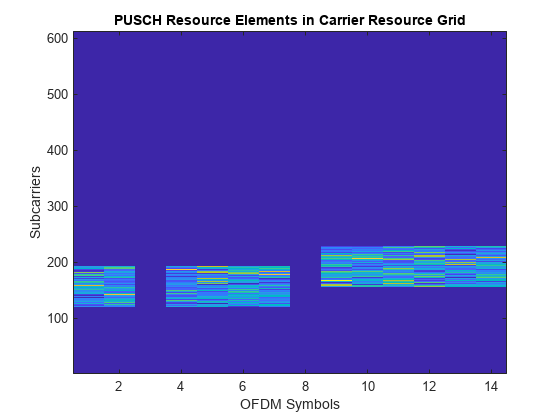nrPUSCH
Generate PUSCH modulation symbols
Syntax
Description
[
returns physical uplink shared channel (PUSCH) modulation symbols, as defined in TS 38.211
Sections 6.3.1.1 to 6.3.1.5 [1]. The process consists of
scrambling with scrambling identity sym,ptrsSym] = nrPUSCH(cw,mod,nLayers,nid,rnti)nid, performing symbol modulation
with modulation scheme mod, and layer mapping. cw
specifies an uplink shared channel (UL-SCH) codeword, as described in TS 38.212 Section
6.2.7 [2].
nLayers specifies the number of transmission layers.
rnti is the radio network temporary identifier (RNTI) of the user
equipment (UE). When you use this syntax, the output ptrsSym is
empty.
[
specifies transform precoding as a logical value. When sym,ptrsSym] = nrPUSCH(cw,mod,nLayers,nid,rnti,transformPrecode,mrb)transformPrecode
is set to true, the function applies the transform precoding defined in
TS 38.211 Section 6.3.1.4. mrb specifies the allocated number of PUSCH
resource blocks. When you use this syntax, the output ptrsSym is
empty.
[
specifies the transmission scheme. When sym,ptrsSym] = nrPUSCH(cw,mod,nLayers,nid,rnti,transformPrecode,mrb,txScheme,nPorts,tpmi)txScheme is set to
'codebook', the function performs multi-input multi-output (MIMO)
precoding based on the specified number of layers nLayers, number of
antenna ports nPorts, and the transmitted precoding matrix indicator
(TPMI) tpmi. When you use this syntax, the output
ptrsSym is empty.
[
returns PUSCH modulation symbols, sym,ptrsSym] = nrPUSCH(carrier,pusch,cw)sym, for the specified carrier
configuration carrier and PUSCH configuration
pusch. The input cw specifies one or two UL-SCH
codewords. The function also returns the precoded phase tracking reference signals (PT-RS)
symbols, ptrsSym, which are mapped to the resource grid. When you use
this syntax with transform precoding, the function maps the data modulated symbols and PT-RS
symbols at appropriate locations prior to starting the transform precoding process.
Examples
Input Arguments
Output Arguments
References
[1] 3GPP TS 38.211. “NR; Physical channels and modulation.” 3rd Generation Partnership Project; Technical Specification Group Radio Access Network.
[2] 3GPP TS 38.212. “NR; Multiplexing and channel coding.” 3rd Generation Partnership Project; Technical Specification Group Radio Access Network.
